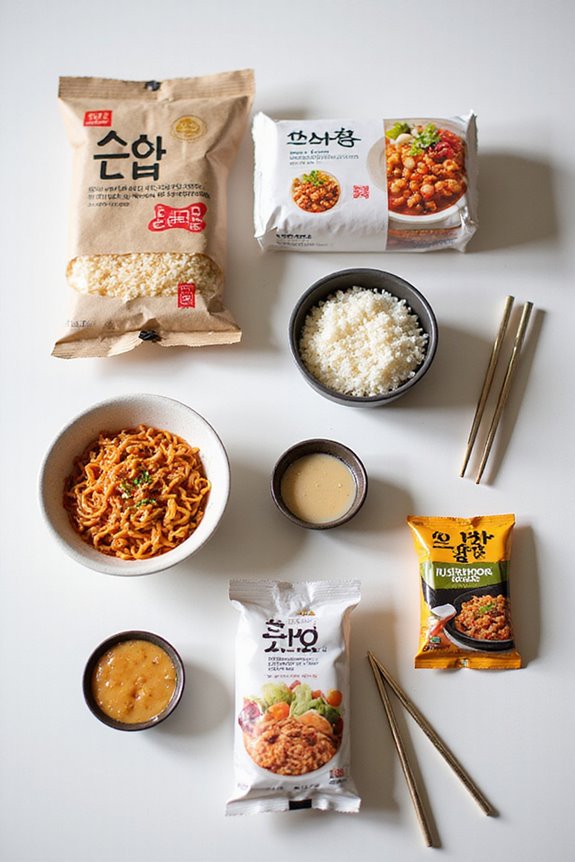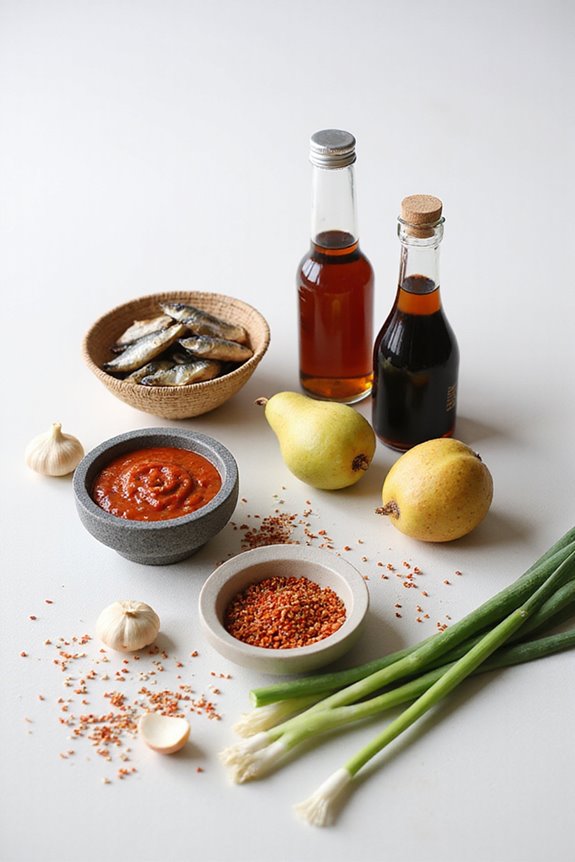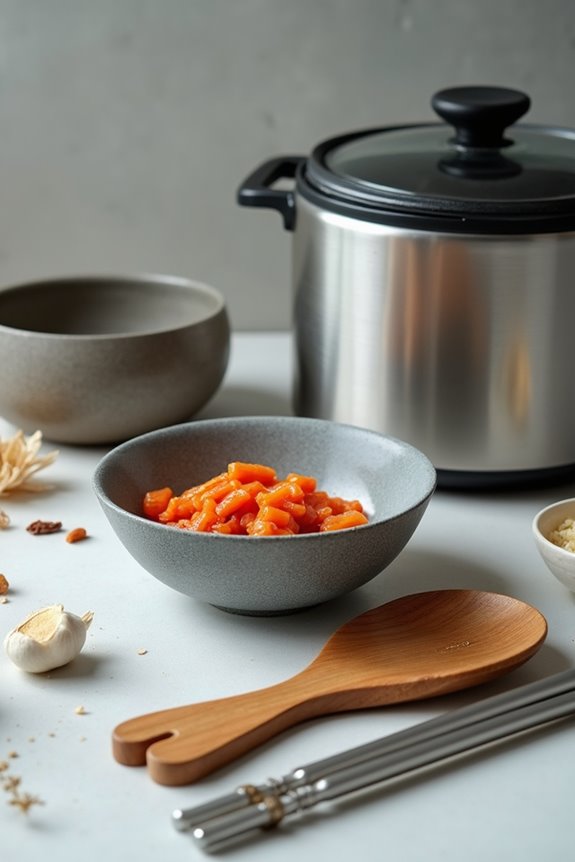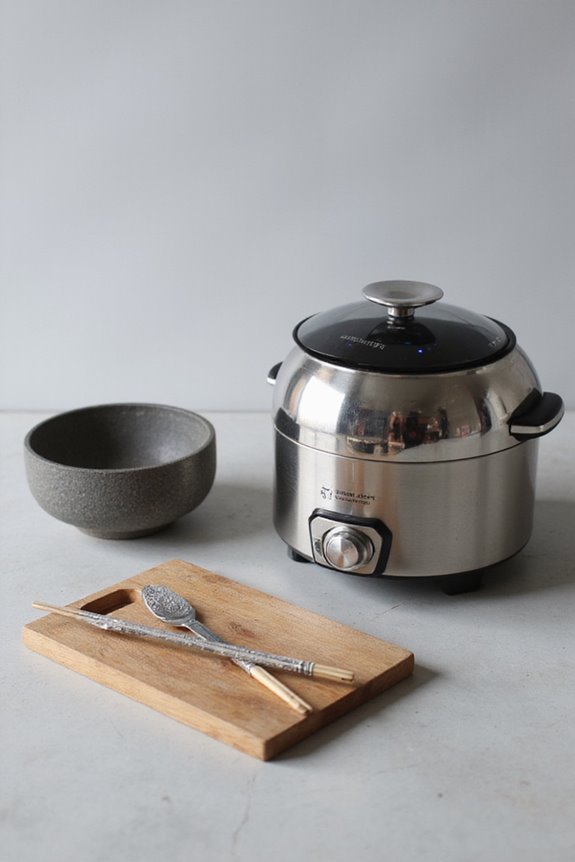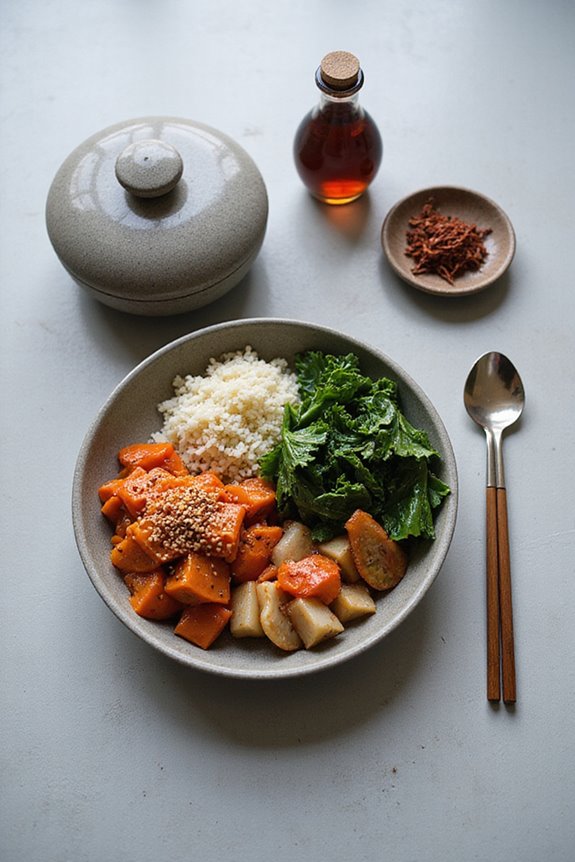Korean instant food options are quite popular, especially their wide variety of instant noodles. Notable types include Shin Ramyun Black, known for its intense heat, and Samyang’s Buldak noodles, celebrated for extreme spiciness. These noodles feature key flavor profiles, balancing spice, umami, and seafood notes. Cooking techniques emphasize using boiling water for proper hydration and flavor distribution. As consumer preferences evolve, many brands adapt by incorporating premium ingredients and innovative packaging. You might discover even more compelling insights ahead.
Key Takeaways
- Popular options include Shin Ramyun Black, Samyang’s Buldak noodles, and Jin Jjambbong, known for their unique flavors and spice levels.
- Korean instant noodles often feature bold flavor profiles like umami, spice, and seafood, appealing to diverse palates.
- Cooking techniques emphasize proper hydration and seasoning for optimal taste and texture in instant noodles.
- Consumers show growing interest in premium, health-conscious, and innovative instant food products, reflecting contemporary dining trends.
- Innovative packaging solutions enhance convenience, including microwavable cups and self-heating technologies for on-the-go consumption.
Popular Varieties of Korean Instant Noodles
When we consider the landscape of Korean instant noodles, several popular varieties stand out due to their unique flavors and textures. Particularly, we find spicy varieties like Shin Ramyun Black from Nongshim and Samyang’s Buldak noodles, both celebrated for their intense heat and delightful chewiness. On the other hand, seafood flavors also have a significant presence, with Jin Jjambbong leading the way as a spicy seafood ramyun known for its grilled notes. Additionally, Nongshim’s Neoguri offers a delightful spicy seafood combination that appeals to a broader palate. Each of these options highlights not only the diversity of flavor profiles in Korean instant noodles but also the craftsmanship behind each product, appealing to both domestic and global markets.
Key Flavor Profiles in Korean Instant Foods
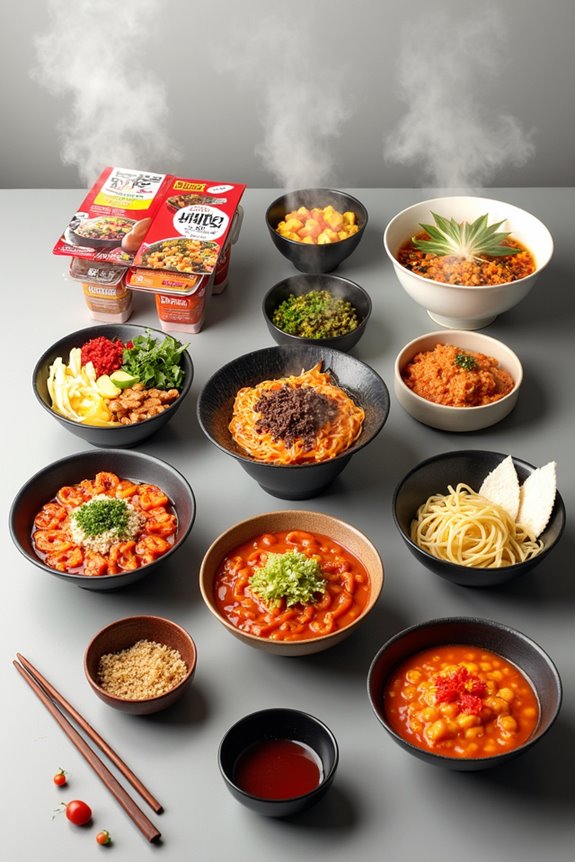
Korean instant foods showcase a diverse range of key flavor profiles that cater to various consumer preferences and dining experiences. One prominent profile is the spicy balance, often achieved through ingredients like gochugaru and gochujang; this can vary from mild heat to the intense flavors found in Buldak-Bokkeum Myeon. Complementing the heat, umami depth is achieved using fermented ingredients such as kimchi and anchovy-based broths. Additionally, many options include sweetness and tanginess, created by sugar or pickled side dishes that counterbalance spice. Seafood flavors further enhance the experience, employing dried shrimp or fish stock to create a briny essence. Ultimately, these profiles offer something for everyone, highlighting both traditional Korean flavors and modern adaptations.
Cooking Techniques for Instant Noodles
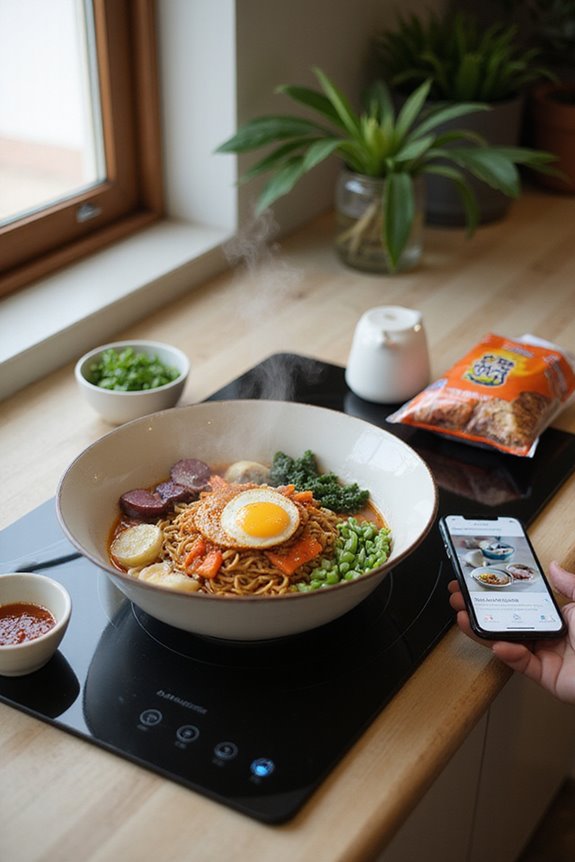
Instant noodles are a popular convenience food, and understanding effective cooking techniques can enhance their flavor and texture markedly. To achieve ideal noodle hydration, we should start with boiling water at 100°C (212°F) and use 500ml to 550ml, depending on personal preferences. Cooking temperature is vital; we cook uncovered at high heat for 3-5 minutes, stirring occasionally to prevent sticking. For ramyeon, we boil noodles with soup powder, cover for 1 minute, then stir and cook for another 1-2 minutes. Adding eggs directly into boiling noodles allows for poaching. During steeping, weighing down instant cup noodle lids retains steam, further enhancing heat retention. Following these techniques guarantees flavorful and chewy noodles that fully absorb the broth’s essence.
Quality Considerations in Instant Noodle Preparation
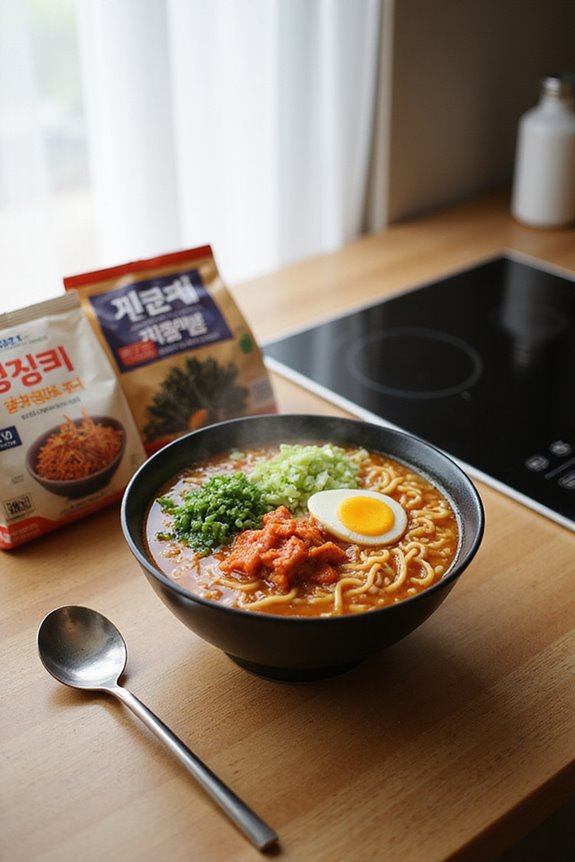
Selecting quality ingredients and using appropriate methods during instant noodle preparation can greatly impact both flavor and nutritional value. By prioritizing ingredient sourcing, we guarantee fresh vegetables and proteins enhance our meal’s taste and health. For example, incorporating eggs or tofu can improve the nutritional balance considerably. Boiling water at the right temperature helps rehydrate dried ingredients properly, so they release their flavors effectively. Adding seasoning packets early allows for even flavor distribution, while lifting noodles intermittently can prevent over-softening. Additionally, we should monitor sodium levels, as instant noodles often contain high sodium content. This awareness helps us achieve a more balanced meal, tailored to our preferences without compromising taste or nutrition, thereby elevating our culinary experience.
Overview of Leading Korean Instant Food Brands
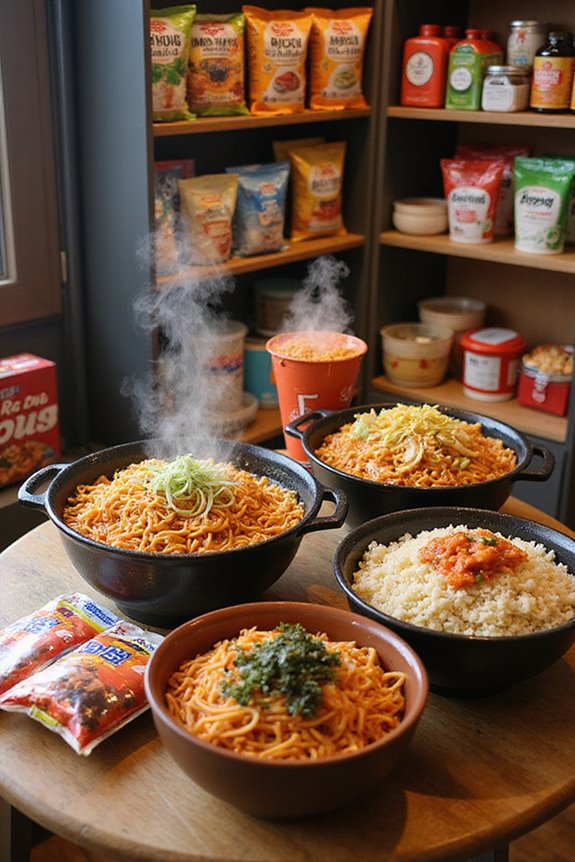
As the global demand for convenient meal solutions increases, an overview of leading instant food brands reveals the vibrant landscape within South Korea’s market. Nongshim stands out with a commanding 56.3% market share, renowned for innovative products like Shin Ramyun and extensive global reach. Samyang Foods follows, famous for its spicy hot chicken ramen, and Ottogi offers a wide array of instant noodles. Paldo continues to diversify flavors while Lotte focuses on quality and innovation. Significantly, brand collaborations enhance product offerings, while targeted market strategies are essential in appealing to health-conscious consumers. The e-commerce boom is driving growth, showcasing the competitive nature of the market and advancing trends towards healthier, convenient meal options.
Types of Korean Instant Foods Beyond Noodles
While many associate Korean instant foods primarily with noodles, the market offers a diverse range of options that cater to various tastes and preferences. For instance, we can find popular rice cakes like tteokbokki, which come with spicy gochujang sauce, or cheese topokki featuring parmesan sauce. Ready-made gimbap varieties, filled with tuna or kimchi, are convenient for meals or snacks. Soup kits, such as instant samgyetang or yukgaejang, provide easy preparations for traditional flavors. Vegetarian options, including vegetable bibimbap kits and pre-cut kimchi, are accessible to all. Additionally, seafood snacks like fried octopus or imitation crab kimbap deliver unique flavors. Finally, dessert beverages, including Sujeonggwa, offer a sweet finish to any meal.
Trends in Korean Instant Food Consumption
The rapid growth and changing dynamics of the Korean instant food market offer crucial insights into consumer behavior and preferences. We’re seeing a notable shift in consumer preferences driven by the increasing prevalence of single-person households and demanding lifestyles, leading many to prioritize convenience. The “honjok” lifestyle highlights this trend, as individuals seek out quick meal solutions that fit their busy schedules. Additionally, the market dynamics reveal rising interest in innovative flavors and premium options, indicating consumers’ willingness to pay more for superior products. E-commerce has emerged as an important channel, reflecting our collective move towards digital shopping. Overall, these trends depict a market poised for steady growth, with expectations of continued evolution in how we consume instant foods.
Traditional vs. Modern Flavors in Instant Noodles
When examining traditional versus modern flavors in instant noodles, it’s clear that this category has undergone considerable transformation over the decades. Traditional flavors primarily included simple chicken broth, reflecting post-war nutritional needs while often emphasizing spicy profiles through the use of red chili peppers. Brands like Samyang and Nongshim pioneered these offerings, creating enduring cultural staples. In contrast, modern innovations have diversified the market considerably, introducing flavors like cheese ramen and non-spicy white broth options. Additionally, the use of ingredients such as seafood, meat, and vegetables has broadened appeal, catering to evolving consumer preferences. This blend of traditional flavors with new concepts illustrates the ongoing evolution of instant noodles within Korean food culture, adapting to contemporary tastes while retaining nostalgic elements.
The Role of Spiciness in Korean Instant Noodle Culture
Spiciness plays an essential role in Korean instant noodle culture, as it not only reflects historic culinary preferences but also shapes contemporary consumer behavior. In South Korea, spicy preferences dominate the instant noodle market, with spicy ramyeon being the favored choice, surpassing milder varieties. This trend originated in the 1960s when red chili powder was introduced, creating a lasting impact on Korean cuisine. The culinary significance of spiciness is evident, as it enhances flavors and offers comforting heat. Today, not only do we see newer spicy variants pushing heat limits, but this bold flavor profile also appeals to younger consumers. Such trends are essential for maintaining Korea’s unique identity in the international instant noodle landscape.
Innovative Packaging and Ingredients in Korean Instant Foods
As we explore innovative packaging and ingredients in Korean instant foods, it’s clear that these advancements are driven by both consumer demands and evolving culinary trends. Many brands focus on packaging sustainability, introducing microwavable options like Nongshim’s Shin Ramyun Black Cup, which withstands up to 100°C. Companies also employ self-heating technologies, such as those found in YABUL COOK’s offerings, enhancing portability and convenience. On the ingredient front, there’s a notable expansion in ingredient sourcing, reflecting international tastes. For example, the adaptation of diverse sauces and premium ingredients in products like bibigo’s potstickers caters to a global audience. These innovations collectively contribute to a richer consumer experience and underscore the dynamic nature of the instant food market in Korea.
Frequently Asked Questions
Are Korean Instant Noodles Vegan or Vegetarian-Friendly?
When we explore Korean instant noodles, we find vegan options that avoid animal ingredients and vegetarian varieties that limit meat. With careful selection, we can enjoy delicious noodles that align with our dietary preferences.
What Beverages Pair Well With Korean Instant Noodles?
When considering beverage pairings for our Korean instant noodles, we love choosing barley tea or fruity soju cocktails. These noodle accompaniments enhance flavors while revitalizing our palate, creating a delightful dining experience together.
How Should Leftover Noodles Be Stored and Reheated?
When it comes to leftover storage, we should use airtight containers and refrigerate or freeze noodles. For reheating methods, boiling or microwaving with moisture helps maintain their texture and flavor. Let’s enjoy our noodles safely!
Can You Customize the Spice Level of Korean Instant Noodles?
When it comes to Korean instant noodles, we can play the spice game: by customizing spice levels and enhancing flavors, we can create our perfect bowl. Let’s mix and match for a deliciously tailored experience!
Where Can I Find Authentic Korean Instant Food Recipes?
We can find authentic Korean instant food recipes on popular Korean food blogs. Additionally, Instant recipe videos on platforms like YouTube offer visual guidance, making it easier for us to create delicious dishes at home.

